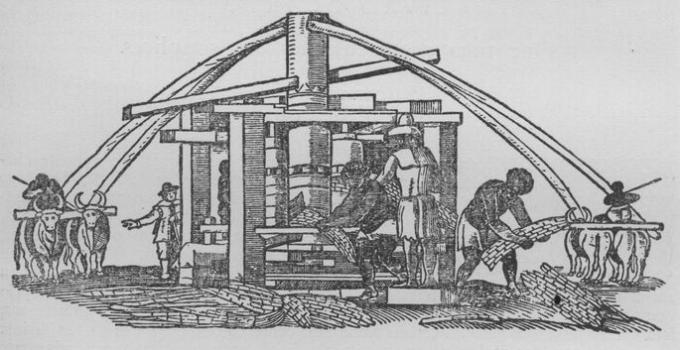O sugar mill designates the place where sugar was produced during the colonial period.
These mills appear in the 16th century, when sugarcane planting began in Brazil.
They had buildings for the milling of sugar cane, places to transform the juice into molasses and brown sugar, a chapel, a house for the owners and a slave quarters for the enslaved.
The first sugarcane seedlings arrived from Portugal in the mid-16th century. The Portuguese already had planting techniques, as they cultivated and manufactured the product on the island of Madeira and the Azores.
Structure of colonial mills
The colonial mill was a large complex divided into several parts:
- cane field: where sugarcane was grown;
- Milling: place to grind the plant and extract the broth. The mill operated by animal traction, water (mill) or even the human force of the enslaved.
- House of Boilers: space used to boil sugarcane juice in holes dug in the ground. The result, a thick liquid, was then boiled in copper pots.
- House of Furnaces: a kind of kitchen that housed large ovens that heated the product and turned it into sugarcane molasses.
- house of purge: there were the molds with the crystallized broth, called sugar loaf. After six to eight days, they were removed from the molds, refined and ready to be sold.
- plantations: In addition to the sugarcane plantations, there were subsistence plantations (gardens), in which fruits, vegetables and vegetables were cultivated for feeding the mill's inhabitants.
- Big house: represented the center of power of the mills, being the place where the owner of the land and his family lived. Despite the imposing name, not all houses were large.
- slave quarters: places that sheltered the enslaved people and where there was no comfort and they slept on the dirt floor. During the night they were chained to prevent leakage
- Chapel: construction made to celebrate the religious rites of the inhabitants of the mill, especially the Portuguese. There, masses and the main Catholic manifestations such as baptisms, weddings, novenas, etc. took place. It is worth remembering that the enslaved were often forced to participate in the cults.
- Free Workers' Houses: small and simple dwellings where the plantation's free workers lived. They were usually specialized employees such as carpenters, sugar masters, etc.
- Corral: housed the animals used in the mills, whether for transport (products and people), in animal-drawn mills or for feeding the population.

Operation of colonial mills
First, sugarcane was cultivated on large tracts of land (large estates), then harvested and taken to the mill, where sugarcane juice was produced.
After this process, the product was taken to the boilers and then to the furnace. Consequently, the molasses from the cane was put into molds and once crystallized it was known as sugar loaf. Finally, it was refined in the purge house and bagged for transport.
Part of it, and especially of the brown sugar (which did not go through the refining process) was destined for internal trade. However, most of the production was sent to supply the European market.
Due to their structure and the large amount of labor, the sugar mills were considered “small towns”. At the end of the 17th century, there were already around 500 sugar mills in Brazil, mainly in the northeast region.
From the 18th century onwards, sugar declined, with competition carried out by the British, Dutch and French in their Caribbean colonies.
In addition, gold deposits were discovered, which started the Gold Cycle in Brazil and, little by little, several sugar mills were deactivated.
The work of the enslaved on the plantations
Enslaved people represented the main labor force on the sugar mills (about 80%) and received no wages. Although most were from Africa, many indigenous enslaved people worked on the colonial plantations.
In addition to working long hours, they lived in terrible conditions, wore rags, were flogged by the foremen and ate very poorly. They worked both in the production of sugarcane and in the manor houses, taking care of the kitchen, cleaning, raising the master's children, etc.
Learn more about the topic by reading the articles:
- Hereditary Captaincies
- Brazil Colony
- Sugarcane Cycle
- slavery in Brazil
- Indigenous Slavery in Colonial Brazil

